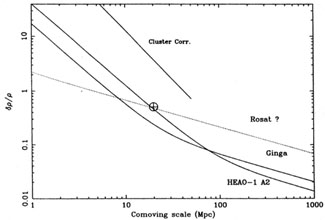Copyright © 1992 by Annual Reviews. All rights reserved
| Annu. Rev. Astron. Astrophys. 1992. 30:
429-456 Copyright © 1992 by Annual Reviews. All rights reserved |
The lack of obvious anisotropies (except for the dipole) in the
high-Galactic latitude XRB strongly suggests that it can provide strong
constraints on the lumpiness of the X-ray Universe Given that its origin
is presumably due to redshifts of 0.5-3, it is striking that the
enormous observed inhomogeneities in the local Universe (voids, walls,
superclusters) are not strongly mapped as anisotropies in the XRB,
diluted of course by the presence of many such structures along the line
of sight. As seen in
Figure 2, some nearby
structures do show through at
the low level of a few percent or less [as indicated by the strength of
W( )], but there are no
signs of the effect of more distant structures,
nor do the isotropy measures allow for much variation or inhomogeneities
in the distribution of the sources that contribute most of the XRB. The
smoothness of the XRB argues that the Universe is smooth on scales
greater than about a hundred Mpc.
)], but there are no
signs of the effect of more distant structures,
nor do the isotropy measures allow for much variation or inhomogeneities
in the distribution of the sources that contribute most of the XRB. The
smoothness of the XRB argues that the Universe is smooth on scales
greater than about a hundred Mpc.
Upper limits to the correlation function on several angular scales are
especially relevant here. Taking z = 1 as a reference redshift. 1 Mpc
corresponds to angular separations of 4 arcmin, implying that the ACF of
the XRB on those scales will be dominated by the extension of the
clustering of clusters of galaxies, galaxies, and QSOs. Recent analyses
of ROSAT deep images, where about 30% of the XRB has been identified as
arising in (subsequently removed) sources, still have very stringent
limits on the autocorrelation function of the residual background (W
 10-3). This
constrains any correlation length of these sources to less
than 4 or 5 Mpc
(Carrera et al 1992)
and may provide strong evidence for
the evolution of clustering in the Universe.
10-3). This
constrains any correlation length of these sources to less
than 4 or 5 Mpc
(Carrera et al 1992)
and may provide strong evidence for
the evolution of clustering in the Universe.
On degree scales, the general upper limit to the ACF is about
10-4 with
a possible detection at the level of 3 x 10-5 at 10°
(Mushotzky 1992).
This leads to similar conclusions about the correlation length. On the
other hand,
Carrera et al (1991a)
found weak evidence for a negative
autocorrelation function on a scale of ~ 2°. Subsequent analysis of some
Ginga scans seems to show a similar tendency although on slightly larger
scales and at a similar significance level (less than
2 ; Carrera et al
1992). This is expected if a few per cent of the XRB arises in sources
following a void- and-wall distribution as is currently seen in optical
redshift surveys
(de Lapparent et al
1986).
; Carrera et al
1992). This is expected if a few per cent of the XRB arises in sources
following a void- and-wall distribution as is currently seen in optical
redshift surveys
(de Lapparent et al
1986).
Upper limits to any excess fluctuations in the P(D) noise (see again
Figure 5) can be directly related to
density fluctuations in the
Universe (
 /
/ ) assuming that X-rays
trace mass. Specific conclusions
require a redshift distribution to be assumed for the X-ray sources
contributing to the background. In Figure 9 we
show upper limits to the
density fluctuations on several comoving scales assuming. for
simplicity, that the XRB comes from a redshift range
) assuming that X-rays
trace mass. Specific conclusions
require a redshift distribution to be assumed for the X-ray sources
contributing to the background. In Figure 9 we
show upper limits to the
density fluctuations on several comoving scales assuming. for
simplicity, that the XRB comes from a redshift range
 z
z  1 around z = 2
and that the source correlation function has a Gaussian shape. Current
upper limits on (
1 around z = 2
and that the source correlation function has a Gaussian shape. Current
upper limits on ( I/I)excess constitute the best direct evidence of
large-scale homogeneity of the Universe at these intermediate redshifts.
If ROSAT or future ~ 1 arcmin resolution telescopes can constrain
(
I/I)excess constitute the best direct evidence of
large-scale homogeneity of the Universe at these intermediate redshifts.
If ROSAT or future ~ 1 arcmin resolution telescopes can constrain
( I/I)excess
I/I)excess
 0.1, relevant upper
limits to the lumpiness of the Universe
on scales
0.1, relevant upper
limits to the lumpiness of the Universe
on scales  10 Mpc will be
found.
10 Mpc will be
found.

|
Figure 9. Upper limits to the density
fluctuations in the Universe as a
function of comoving scale (see text for details) derived from upper
limits on excess fluctuations. The dotted curve illustrates the
constraints obtained if an upper limit of 10% is obtained from an
instrument with an ~ arcmin beam. The solid point represents a present
mass overdensity of 1.4 on a scale of 37h-1 Mpc, as
inferred for the Shapley Supercluster by
Fabian (1991).
Astro-D should enable limits to
be placed which are about ten times lower (in
|